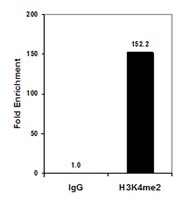05-1338-S Sigma-AldrichAnti-Dimethyl Histone H3 (Lys4) Antibody, clone CMA303, Trial Size
Anti-Dimethyl Histone H3 (Lys4) Antibody, clone CMA303 is a mouse monoclonal antibody for detection of Dimethyl Histone H3 (Lys4) also known as H3K4me2, Histone H3 (di methyl K4). Demonstrated performance in ChIP, DB, ELISA, ICC, IP, WB, Mplex.
More>> Anti-Dimethyl Histone H3 (Lys4) Antibody, clone CMA303 is a mouse monoclonal antibody for detection of Dimethyl Histone H3 (Lys4) also known as H3K4me2, Histone H3 (di methyl K4). Demonstrated performance in ChIP, DB, ELISA, ICC, IP, WB, Mplex. Less<<MSDS (material safety data sheet) or SDS, CoA and CoQ, dossiers, brochures and other available documents.
Recommended Products
概述
| Replacement Information |
|---|
重要规格表
| Species Reactivity | Key Applications | Host | Format | Antibody Type |
|---|---|---|---|---|
| H, Vrt | WB, ChIP, ICC, IP, Mplex, DB, ELISA | M | Purified | Monoclonal Antibody |
| References |
|---|
| Product Information | |
|---|---|
| Format | Purified |
| Presentation | Purified mouse monoclonal IgG1κ in PBS with 0.05% sodium azide. |
| Quality Level | MQ100 |
| Physicochemical Information |
|---|
| Dimensions |
|---|
| Materials Information |
|---|
| Toxicological Information |
|---|
| Safety Information according to GHS |
|---|
| Safety Information |
|---|
| Packaging Information | |
|---|---|
| Material Size | 10 µg |
| Transport Information |
|---|
| Supplemental Information |
|---|
| Specifications |
|---|
| Global Trade Item Number | |
|---|---|
| 产品目录编号 | GTIN |
| 05-1338-S | 04053252929892 |
Documentation
Anti-Dimethyl Histone H3 (Lys4) Antibody, clone CMA303, Trial Size MSDS
| 职位 |
|---|











